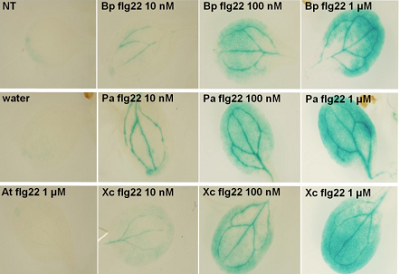Plants recognize beneficial or harmful micro-organisms through Microbe-Associated Molecular Patterns (MAMPs). Our researches focus on the characterization of amphiphilic MAMPs from bacteria (glycolipids and lipopeptides). We aim at dissecting the molecular mechanisms involved in the plant immune responses triggered by the sensing of these molecules (signalling and production of defence metabolites).
Immunity and perception of elicitors


Our key biological questions
- What are the membrane or membrane-associated components involved in amphiphilic MAMPs sensing?
- How does lipid membrane composition alter perception of these MAMPs?
- What are the secondary metabolites produced after perception of these molecules?
- What are the key players involved in the molecular dialog between local and systemic resistance?

Our key results
- Rhamnolipids from pathogenic Pseudomonas are sensed by Arabidopsis thaliana and activate an immune response. Deciphering signaling responses involved in rhamnolipid-triggered immunity highlighted a key role of salicylic acid (Varnier et al. 2009 ; Sanchez et al. 2012 ; Sanchez et al. 2013).
- Synthetic rhamnolipid bolaforms are perceived by A. thaliana at the plasma membrane level and activate plant defence responses (Menhour et al. 2015 ; Nasir et al. 2017).
- Lipopeptides from B. subtilis (surfactin, mycosubtilin et plipastatin) are sensed as MAMPs by V. vinifera et A. thaliana (Farace et al. 2015 ; Debois et al. 2015).
- Modifications of sphingolipid content affect tolerance to plant pathogens by modulating defense responses in A. thaliana (Magnin Robert et al. 2015).
